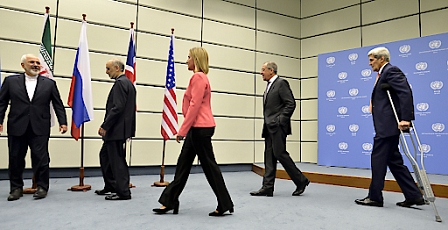Erstellt am: 14. 7. 2015 - 14:35 Uhr
FINALLY!

APA/Herbert Neubauer
It Has Finally Happened
Back in August of 2003, an Iranian political opposition group living in exile, informed the world that a nuclear fuel production facility was being built in Natanz, a city smack-dab in the center of Iran. The world (well, actually only the UK, Germany and France - the US wasn't bothered at first) took heed of an IAEA report which concluded that Iran had failed to meet its obligations under a nuclear production safeguards agreement and the three European countries started a diplomatic effort to keep Iran's nuclear plans transparent.
A LOT happened since then but let's fast-forward to today and FINALLY!
After 18 days of intense negotiations (plus the 12 years of negotiations before that), world powers and Iran struck a landmark deal today to curb Iran's nuclear program. Iran gets billions of dollars in relief from international sanctions for reaching and sticking to the deal.
Bethany Bell has followed the talks for years and was at the historic press conference announcing the deal in Vienna.
Dieses Element ist nicht mehr verfügbar
Mark Fitzpatrick from the International Institute for Strategic Studies gave us some insight with regards to the particulars of the deal.
Dieses Element ist nicht mehr verfügbar
Shashank Joshi, our Middle East analyst, gave us his take on the historic value of the deal.
Dieses Element ist nicht mehr verfügbar
Hello #Pluto! We’re at closest approach. Congrats to all! Follow our story & view new images using #PlutoFlyby. pic.twitter.com/8JVlJrcUkY
— NASA New Horizons (@NASANewHorizons) July 14, 2015It looks like it didn't take hell to freeze over for an Iranian nuclear deal to be reached but to make the day even more historic, the icy weird geology of Pluto has been reached today too!
With a camera.
On NASA's space probe called New Horizons which is hovering roughly 12,500 kilometres above the surface of Pluto, the closest we (humans) have ever been to the dwarf planet.
There's a live feed where you can get images as they arrive on Earth.
There's also a great explanation as to why this is MAJOR, thanks to Peter Bond, the author of Distant Worlds.
Dieses Element ist nicht mehr verfügbar


